Australian Share Market Assignment PDF
VerifiedAdded on 2021/05/27
|7
|1195
|24
AI Summary
Contribute Materials
Your contribution can guide someone’s learning journey. Share your
documents today.
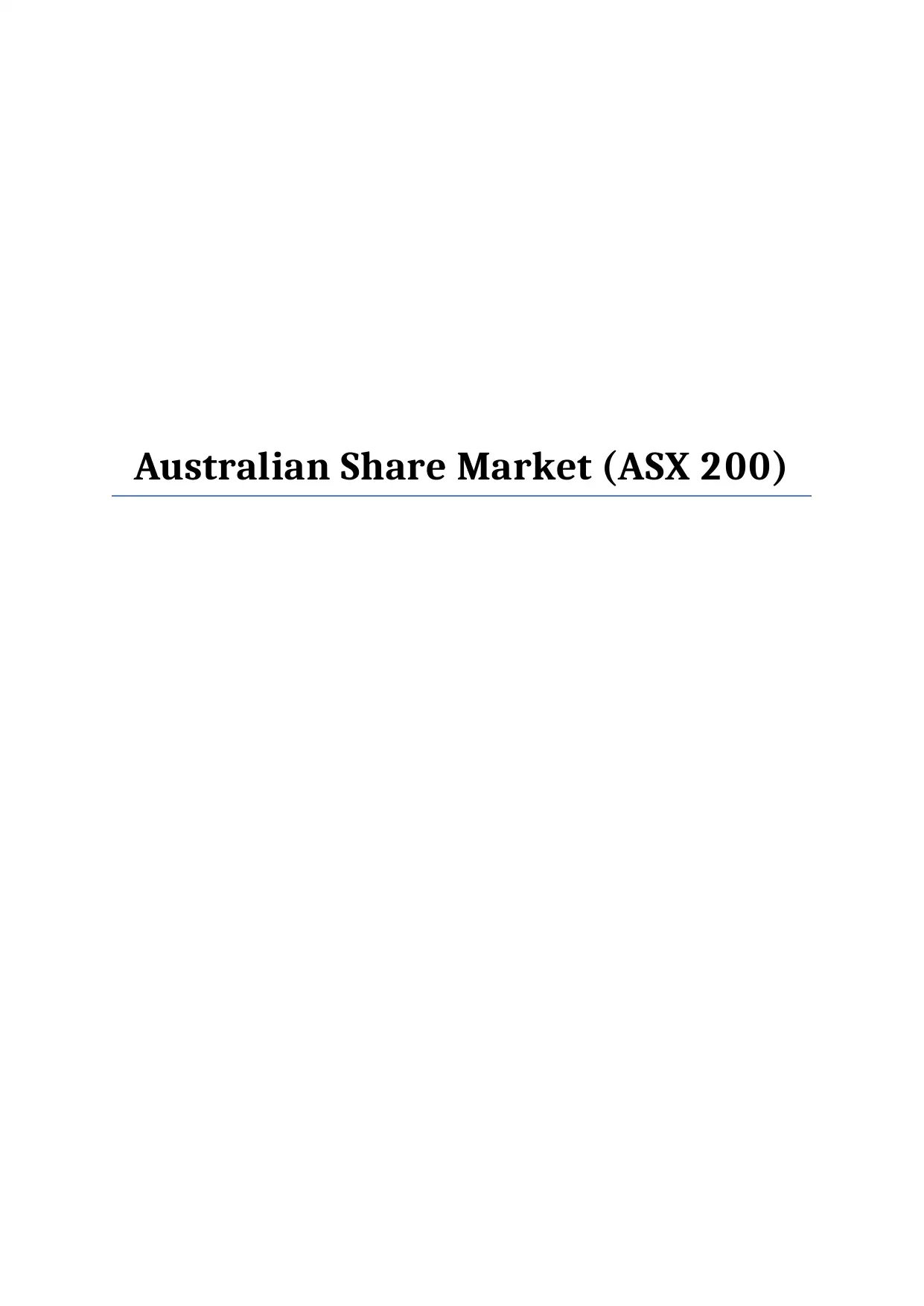
Australian Share Market (ASX 200)
Secure Best Marks with AI Grader
Need help grading? Try our AI Grader for instant feedback on your assignments.
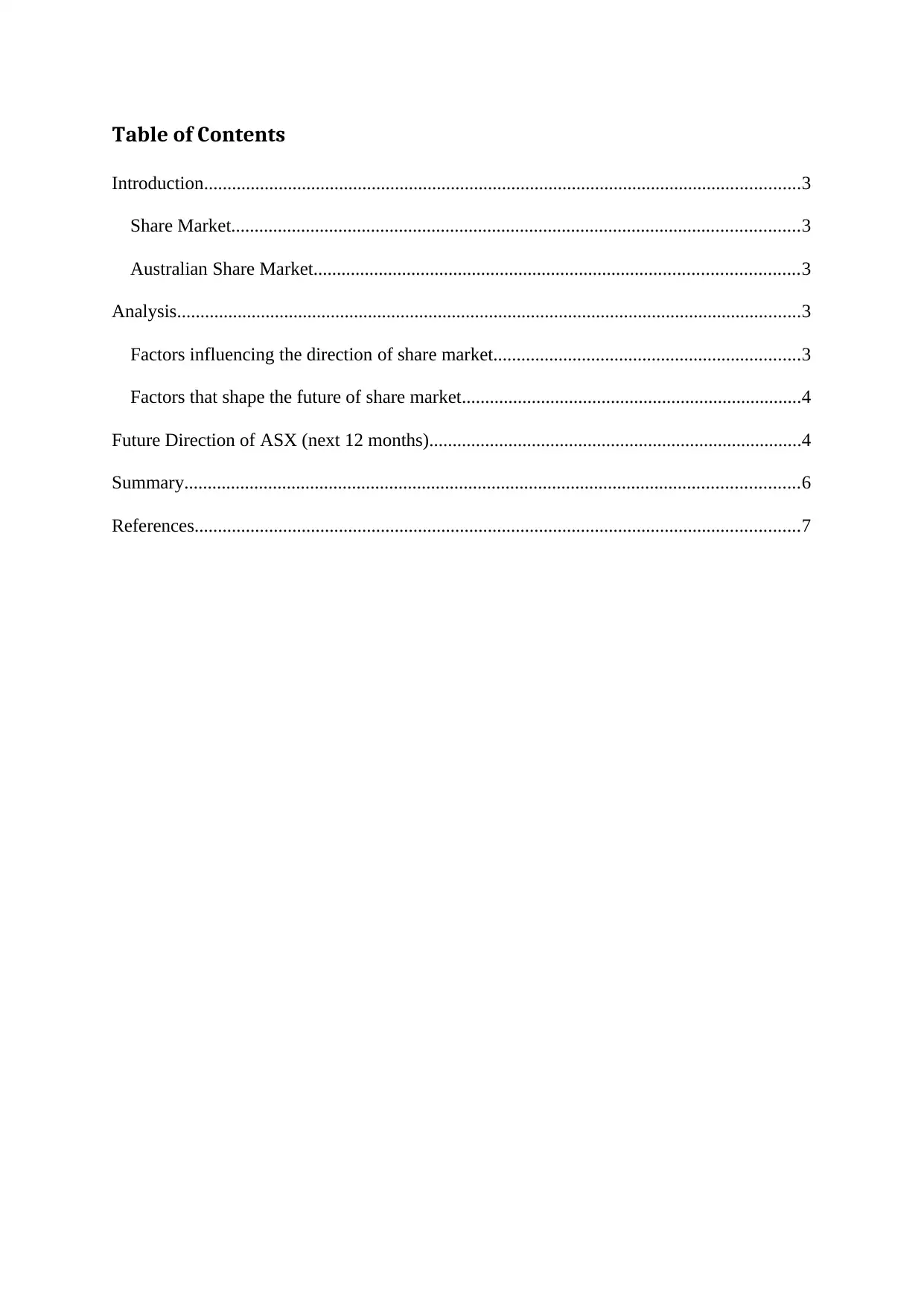
Table of Contents
Introduction................................................................................................................................3
Share Market..........................................................................................................................3
Australian Share Market........................................................................................................3
Analysis......................................................................................................................................3
Factors influencing the direction of share market..................................................................3
Factors that shape the future of share market.........................................................................4
Future Direction of ASX (next 12 months)................................................................................4
Summary....................................................................................................................................6
References..................................................................................................................................7
Introduction................................................................................................................................3
Share Market..........................................................................................................................3
Australian Share Market........................................................................................................3
Analysis......................................................................................................................................3
Factors influencing the direction of share market..................................................................3
Factors that shape the future of share market.........................................................................4
Future Direction of ASX (next 12 months)................................................................................4
Summary....................................................................................................................................6
References..................................................................................................................................7
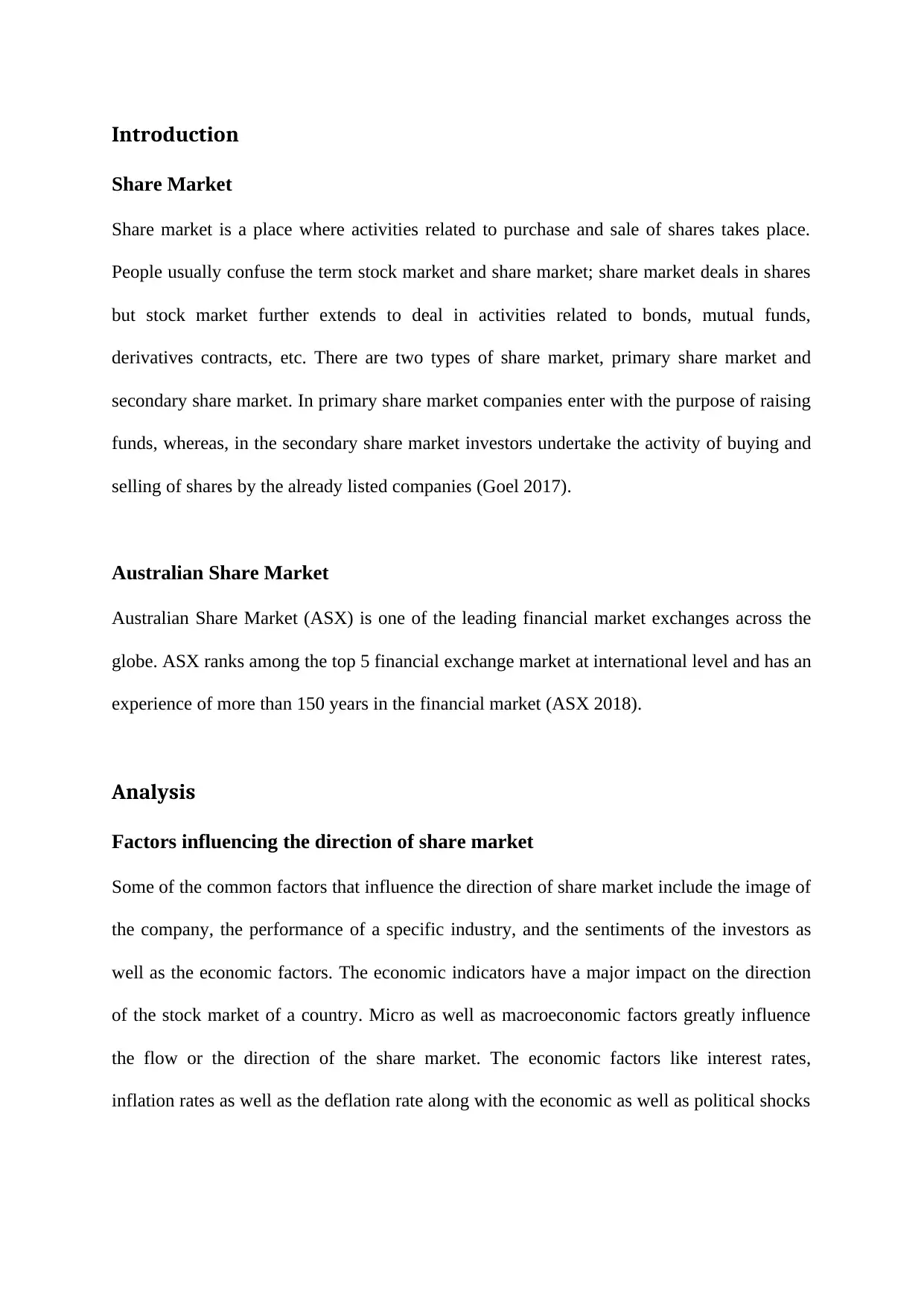
Introduction
Share Market
Share market is a place where activities related to purchase and sale of shares takes place.
People usually confuse the term stock market and share market; share market deals in shares
but stock market further extends to deal in activities related to bonds, mutual funds,
derivatives contracts, etc. There are two types of share market, primary share market and
secondary share market. In primary share market companies enter with the purpose of raising
funds, whereas, in the secondary share market investors undertake the activity of buying and
selling of shares by the already listed companies (Goel 2017).
Australian Share Market
Australian Share Market (ASX) is one of the leading financial market exchanges across the
globe. ASX ranks among the top 5 financial exchange market at international level and has an
experience of more than 150 years in the financial market (ASX 2018).
Analysis
Factors influencing the direction of share market
Some of the common factors that influence the direction of share market include the image of
the company, the performance of a specific industry, and the sentiments of the investors as
well as the economic factors. The economic indicators have a major impact on the direction
of the stock market of a country. Micro as well as macroeconomic factors greatly influence
the flow or the direction of the share market. The economic factors like interest rates,
inflation rates as well as the deflation rate along with the economic as well as political shocks
Share Market
Share market is a place where activities related to purchase and sale of shares takes place.
People usually confuse the term stock market and share market; share market deals in shares
but stock market further extends to deal in activities related to bonds, mutual funds,
derivatives contracts, etc. There are two types of share market, primary share market and
secondary share market. In primary share market companies enter with the purpose of raising
funds, whereas, in the secondary share market investors undertake the activity of buying and
selling of shares by the already listed companies (Goel 2017).
Australian Share Market
Australian Share Market (ASX) is one of the leading financial market exchanges across the
globe. ASX ranks among the top 5 financial exchange market at international level and has an
experience of more than 150 years in the financial market (ASX 2018).
Analysis
Factors influencing the direction of share market
Some of the common factors that influence the direction of share market include the image of
the company, the performance of a specific industry, and the sentiments of the investors as
well as the economic factors. The economic indicators have a major impact on the direction
of the stock market of a country. Micro as well as macroeconomic factors greatly influence
the flow or the direction of the share market. The economic factors like interest rates,
inflation rates as well as the deflation rate along with the economic as well as political shocks

being experienced by the country. Changes in the economic policy also have a direct impact
on the share market of a country (OSC 2018).
Factors that shape the future of share market
The major factors that has the ability to shape the market trends include
Government: Though monetary as well as fiscal policies the government regulates the
economic factors of the country on a regular basis. Government policies have the ability to
change the current as well as future economic conditions. Hence, any new policy starts new
speculations in the market giving a new direction to the share market.
International Transactions: The flow of funds has the ability to strengthen the economic
conditions of the country as well as the currency of the company in the international market.
The money earned because of the increased value of money can strengthen the financial
market of the country.
Speculations: The future of the share market highly depends on the current actions of the
market. In order to predict the future sentiment indicators are highly used to gauge the present
as well as the future trends of the share market. Analysis of this indicator along with technical
analysis and fundamental analysis helps in predicting the future trends as well as future prices
of the shares.
Supply and demand: Supply and demand in the market creates a push and pull in the prices
of the share market. Changes in supply and demand are directly proportional to changes in
prices and rates (Mitchell 2018).
Future Direction of ASX (next 12 months)
The Australian economy seems to grow at continuous pace. The agency of OECD is
expecting 2.8 percent rise on the GDP growth rate in the coming years, which will be driven
on the share market of a country (OSC 2018).
Factors that shape the future of share market
The major factors that has the ability to shape the market trends include
Government: Though monetary as well as fiscal policies the government regulates the
economic factors of the country on a regular basis. Government policies have the ability to
change the current as well as future economic conditions. Hence, any new policy starts new
speculations in the market giving a new direction to the share market.
International Transactions: The flow of funds has the ability to strengthen the economic
conditions of the country as well as the currency of the company in the international market.
The money earned because of the increased value of money can strengthen the financial
market of the country.
Speculations: The future of the share market highly depends on the current actions of the
market. In order to predict the future sentiment indicators are highly used to gauge the present
as well as the future trends of the share market. Analysis of this indicator along with technical
analysis and fundamental analysis helps in predicting the future trends as well as future prices
of the shares.
Supply and demand: Supply and demand in the market creates a push and pull in the prices
of the share market. Changes in supply and demand are directly proportional to changes in
prices and rates (Mitchell 2018).
Future Direction of ASX (next 12 months)
The Australian economy seems to grow at continuous pace. The agency of OECD is
expecting 2.8 percent rise on the GDP growth rate in the coming years, which will be driven
Secure Best Marks with AI Grader
Need help grading? Try our AI Grader for instant feedback on your assignments.
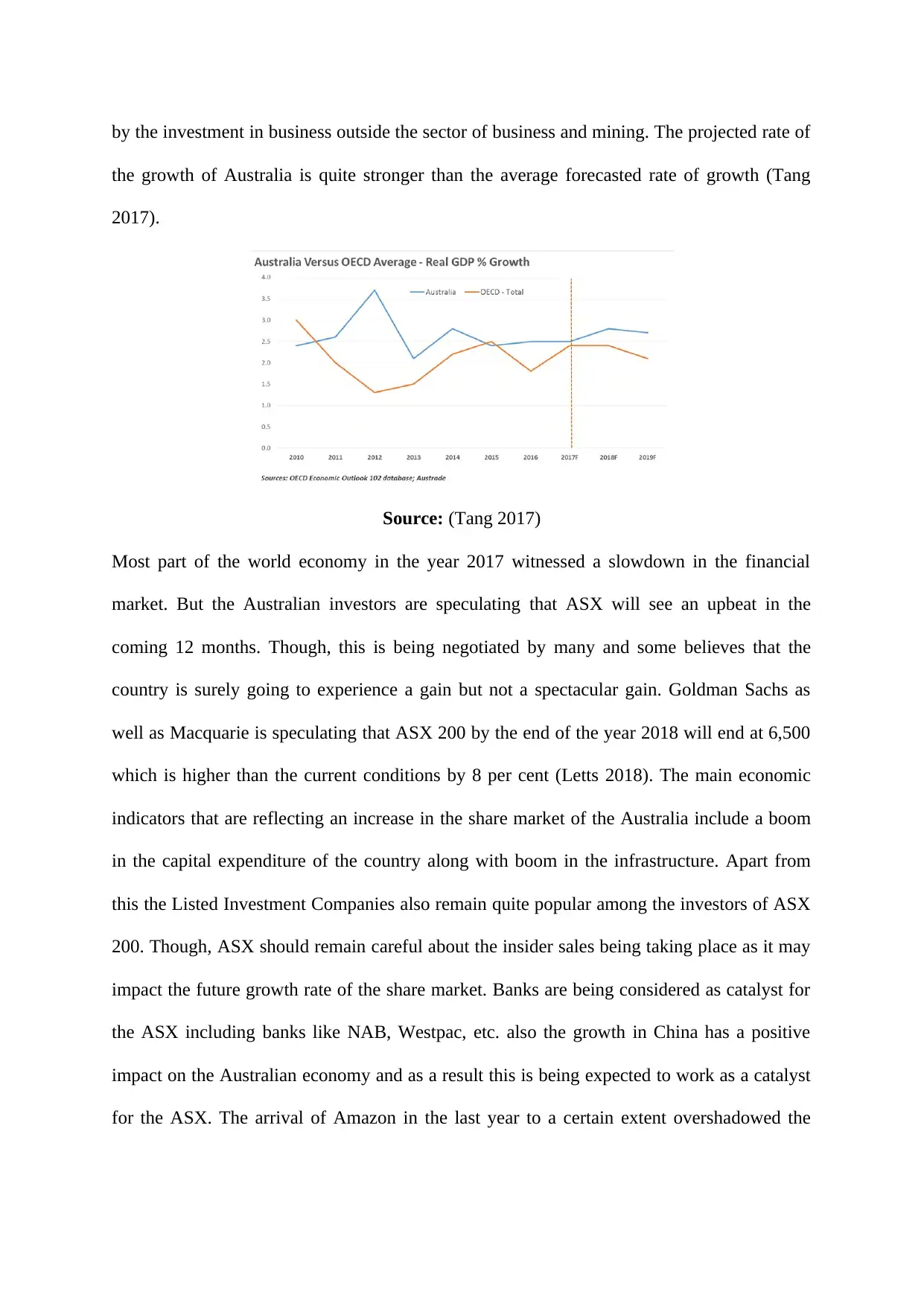
by the investment in business outside the sector of business and mining. The projected rate of
the growth of Australia is quite stronger than the average forecasted rate of growth (Tang
2017).
Source: (Tang 2017)
Most part of the world economy in the year 2017 witnessed a slowdown in the financial
market. But the Australian investors are speculating that ASX will see an upbeat in the
coming 12 months. Though, this is being negotiated by many and some believes that the
country is surely going to experience a gain but not a spectacular gain. Goldman Sachs as
well as Macquarie is speculating that ASX 200 by the end of the year 2018 will end at 6,500
which is higher than the current conditions by 8 per cent (Letts 2018). The main economic
indicators that are reflecting an increase in the share market of the Australia include a boom
in the capital expenditure of the country along with boom in the infrastructure. Apart from
this the Listed Investment Companies also remain quite popular among the investors of ASX
200. Though, ASX should remain careful about the insider sales being taking place as it may
impact the future growth rate of the share market. Banks are being considered as catalyst for
the ASX including banks like NAB, Westpac, etc. also the growth in China has a positive
impact on the Australian economy and as a result this is being expected to work as a catalyst
for the ASX. The arrival of Amazon in the last year to a certain extent overshadowed the
the growth of Australia is quite stronger than the average forecasted rate of growth (Tang
2017).
Source: (Tang 2017)
Most part of the world economy in the year 2017 witnessed a slowdown in the financial
market. But the Australian investors are speculating that ASX will see an upbeat in the
coming 12 months. Though, this is being negotiated by many and some believes that the
country is surely going to experience a gain but not a spectacular gain. Goldman Sachs as
well as Macquarie is speculating that ASX 200 by the end of the year 2018 will end at 6,500
which is higher than the current conditions by 8 per cent (Letts 2018). The main economic
indicators that are reflecting an increase in the share market of the Australia include a boom
in the capital expenditure of the country along with boom in the infrastructure. Apart from
this the Listed Investment Companies also remain quite popular among the investors of ASX
200. Though, ASX should remain careful about the insider sales being taking place as it may
impact the future growth rate of the share market. Banks are being considered as catalyst for
the ASX including banks like NAB, Westpac, etc. also the growth in China has a positive
impact on the Australian economy and as a result this is being expected to work as a catalyst
for the ASX. The arrival of Amazon in the last year to a certain extent overshadowed the
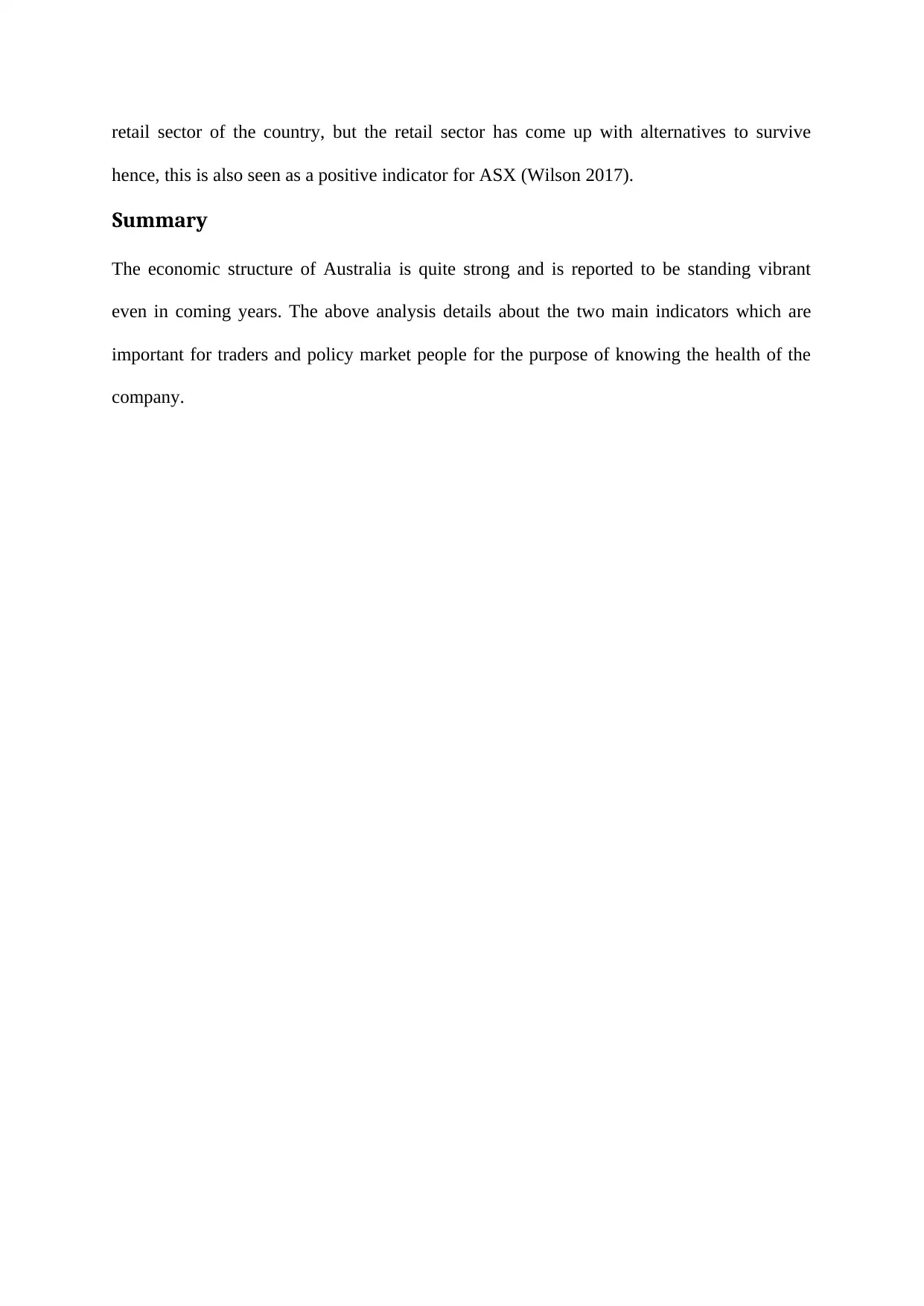
retail sector of the country, but the retail sector has come up with alternatives to survive
hence, this is also seen as a positive indicator for ASX (Wilson 2017).
Summary
The economic structure of Australia is quite strong and is reported to be standing vibrant
even in coming years. The above analysis details about the two main indicators which are
important for traders and policy market people for the purpose of knowing the health of the
company.
hence, this is also seen as a positive indicator for ASX (Wilson 2017).
Summary
The economic structure of Australia is quite strong and is reported to be standing vibrant
even in coming years. The above analysis details about the two main indicators which are
important for traders and policy market people for the purpose of knowing the health of the
company.
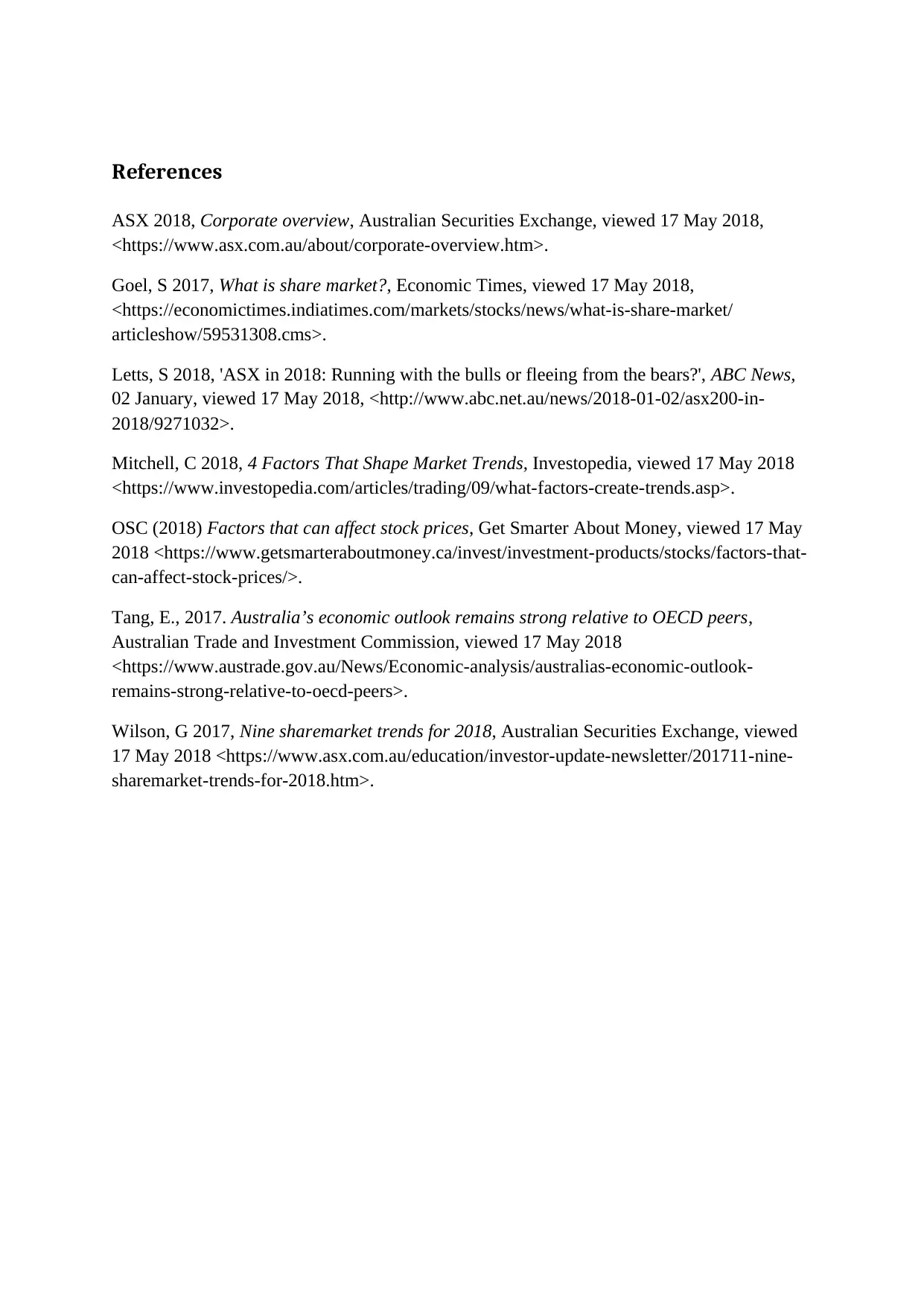
References
ASX 2018, Corporate overview, Australian Securities Exchange, viewed 17 May 2018,
<https://www.asx.com.au/about/corporate-overview.htm>.
Goel, S 2017, What is share market?, Economic Times, viewed 17 May 2018,
<https://economictimes.indiatimes.com/markets/stocks/news/what-is-share-market/
articleshow/59531308.cms>.
Letts, S 2018, 'ASX in 2018: Running with the bulls or fleeing from the bears?', ABC News,
02 January, viewed 17 May 2018, <http://www.abc.net.au/news/2018-01-02/asx200-in-
2018/9271032>.
Mitchell, C 2018, 4 Factors That Shape Market Trends, Investopedia, viewed 17 May 2018
<https://www.investopedia.com/articles/trading/09/what-factors-create-trends.asp>.
OSC (2018) Factors that can affect stock prices, Get Smarter About Money, viewed 17 May
2018 <https://www.getsmarteraboutmoney.ca/invest/investment-products/stocks/factors-that-
can-affect-stock-prices/>.
Tang, E., 2017. Australia’s economic outlook remains strong relative to OECD peers,
Australian Trade and Investment Commission, viewed 17 May 2018
<https://www.austrade.gov.au/News/Economic-analysis/australias-economic-outlook-
remains-strong-relative-to-oecd-peers>.
Wilson, G 2017, Nine sharemarket trends for 2018, Australian Securities Exchange, viewed
17 May 2018 <https://www.asx.com.au/education/investor-update-newsletter/201711-nine-
sharemarket-trends-for-2018.htm>.
ASX 2018, Corporate overview, Australian Securities Exchange, viewed 17 May 2018,
<https://www.asx.com.au/about/corporate-overview.htm>.
Goel, S 2017, What is share market?, Economic Times, viewed 17 May 2018,
<https://economictimes.indiatimes.com/markets/stocks/news/what-is-share-market/
articleshow/59531308.cms>.
Letts, S 2018, 'ASX in 2018: Running with the bulls or fleeing from the bears?', ABC News,
02 January, viewed 17 May 2018, <http://www.abc.net.au/news/2018-01-02/asx200-in-
2018/9271032>.
Mitchell, C 2018, 4 Factors That Shape Market Trends, Investopedia, viewed 17 May 2018
<https://www.investopedia.com/articles/trading/09/what-factors-create-trends.asp>.
OSC (2018) Factors that can affect stock prices, Get Smarter About Money, viewed 17 May
2018 <https://www.getsmarteraboutmoney.ca/invest/investment-products/stocks/factors-that-
can-affect-stock-prices/>.
Tang, E., 2017. Australia’s economic outlook remains strong relative to OECD peers,
Australian Trade and Investment Commission, viewed 17 May 2018
<https://www.austrade.gov.au/News/Economic-analysis/australias-economic-outlook-
remains-strong-relative-to-oecd-peers>.
Wilson, G 2017, Nine sharemarket trends for 2018, Australian Securities Exchange, viewed
17 May 2018 <https://www.asx.com.au/education/investor-update-newsletter/201711-nine-
sharemarket-trends-for-2018.htm>.
1 out of 7
Related Documents
Your All-in-One AI-Powered Toolkit for Academic Success.
+13062052269
info@desklib.com
Available 24*7 on WhatsApp / Email
![[object Object]](/_next/static/media/star-bottom.7253800d.svg)
Unlock your academic potential
© 2024 | Zucol Services PVT LTD | All rights reserved.




